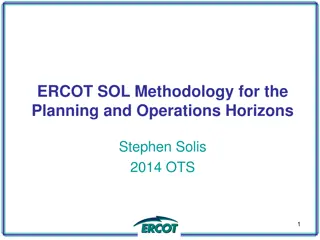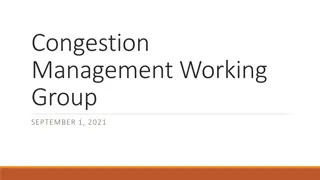Enhancing ERCOT's Capacity Assessment with Demand Response Monitoring
Demand response in ERCOT has been increasing, with forecasts of continued growth. The system operator can identify MW peaks by analyzing total ERCOT load data. A proposed Demand Response Monitor would assist in predicting future capacity needs based on responses from loads like LMP energy prices and conservation alerts. The monitor would select loads using historical data, avoiding intrusive reporting requirements on retail loads. The Large Flexible Load Task Force recommends publishing aggregate response data on the ERCOT website for enhanced operator insights.
Download Presentation

Please find below an Image/Link to download the presentation.
The content on the website is provided AS IS for your information and personal use only. It may not be sold, licensed, or shared on other websites without obtaining consent from the author.If you encounter any issues during the download, it is possible that the publisher has removed the file from their server.
You are allowed to download the files provided on this website for personal or commercial use, subject to the condition that they are used lawfully. All files are the property of their respective owners.
The content on the website is provided AS IS for your information and personal use only. It may not be sold, licensed, or shared on other websites without obtaining consent from the author.
E N D
Presentation Transcript
Demand Response Monitor Demand Side Working Group Floyd J. Trefny June 21 2024
Demand Response in ERCOT Since the inception of ERCOT, Demand Response from loads has increased. Significant new Demand Responsive Load is forecast to continue increasing over the next few years. Today, over 3000 MWs of new Flexible Load is operating in real-time. ERCOT operators need a better understanding of demand response occurring in real- time to better understand risks during projected critical shortages of generation capacity to serve load. A Demand Response Monitor is proposed to assist operators in making judgements of near-future capacity needs. The Monitor would detect responses by loads attributable to: LMP Energy Price 4CP Near 4CP Conservation Alerts Over time, empirical data collected by ERCOT could also used by ERCOT to predict future Demand Response for other reliability applications.
How Can the System Operator Know When a MW Peak Has Occurred? Time 17:08 For Example: Total ERCOT Demand System Time 17:08 ERCOT Total Load* 72,327 MWs Peak 72,548 MWs Time @ Measured Peak 16:47 * Total ERCOT Load is calculated as sum of total generation and DC tie telemetry (total generation could exclude renewables if the objective is to determine peak NET Load)
Demand Response Monitor Time 14:08 Current Responsive Load 2012 Mw Peak 2922 Mw Observed Response 910 Mw West 22 Mw 705 Mw 13:10 East 5 Mw 175 Mw 13:31 LMP $50 LMP Central 920 Mw 920 Mw 14:08 Demand Response Monitor 1000 600.00 900 500.00 800 LMP $1000 LMP $400 700 400.00 600 LMP $75 500 300.00 LMP $50 400 Gulf Coast 765 Mw 802 Mw 13:55 200.00 300 Valley 318 Mw 320 Mw 14:08 200 100.00 100 0 0.00 120 115 110 105 100 95 90 85 80 75 70 65 60 55 50 45 40 35 30 25 20 15 10 5 SCED Run Demand Response System LMP
Demand Response Monitor The Demand Response Monitor would select various loads by analysis of past operations using historical State Estimator data. State Estimator Loads are in MWs. ERCOT staff has indicated this is doable. The methodology used to select which loads to use would be very similar to that employed in the past by ERCOT to analyze energy response using changes in kWh meter readings. Presentations were made periodically to the Demand Side Working Group and WMS that showed aggregate load response. ERCOT would select substation loads that have response characteristics. It is not necessary to be precise to gain insight into real-time load changes. The Demand Response Monitor would obviate the need for imposition of highly intrusive data reporting requirement on retail loads.
NPRR 1226 Demand Response Monitor The Large Flexible Load Task Force has reviewed the need for this monitor and has recommended that the aggregate of the total response being observed be published on the ERCOT website. ERCOT Operators would have more detail information. ERCOT would make sure any confidential information on loads is not exposed to the public. NPRR 1226 requires ERCOT to publish the aggregate demand response from each SCED run for the last two hours in graphical format including SCED LMPs. Market Participants are encouraged to file supporting comments to PRS. Demand Response Monitor LMP 1000 600.00 900 500.00 800 700 400.00 600 500 300.00 400 200.00 300 200 100.00 100 0 0.00 95 90 85 80 75 70 65 60 55 50 45 40 35 30 25 20 15 10 5 120 115 110 105 100 SCED Run Demand Response System LMP























